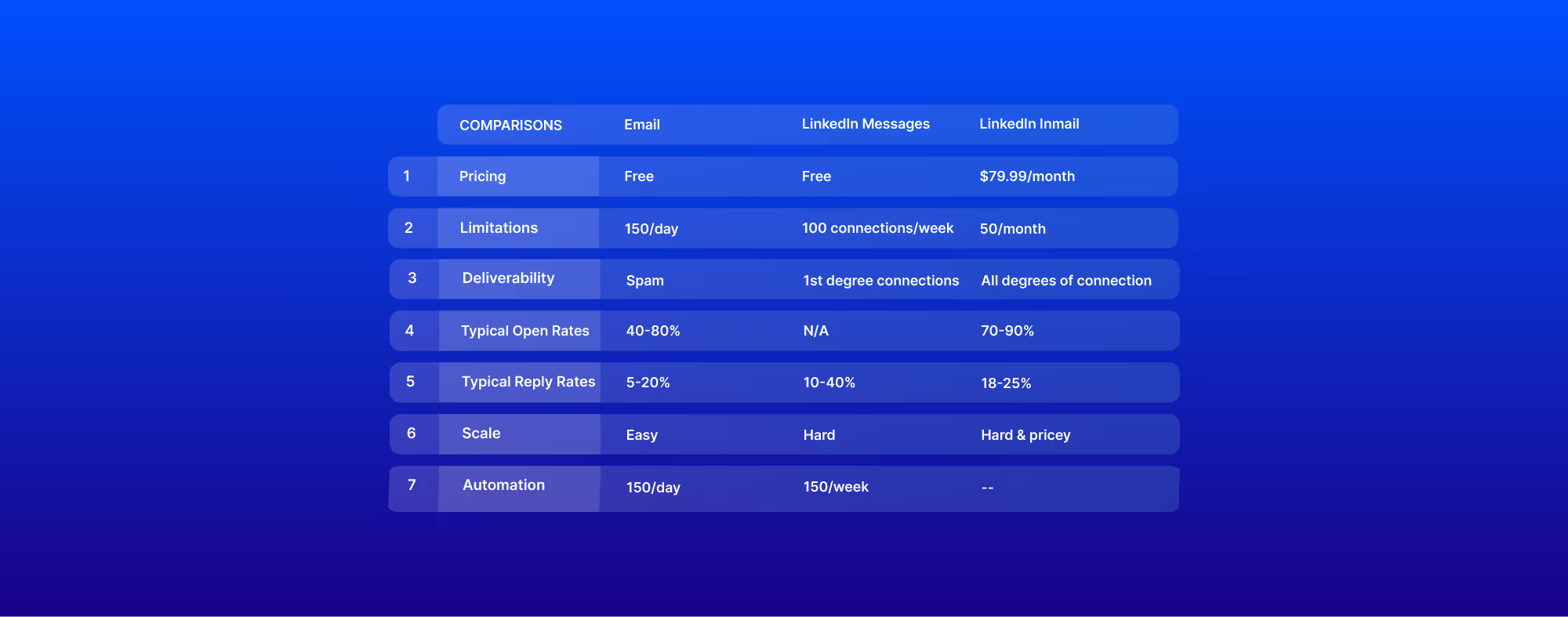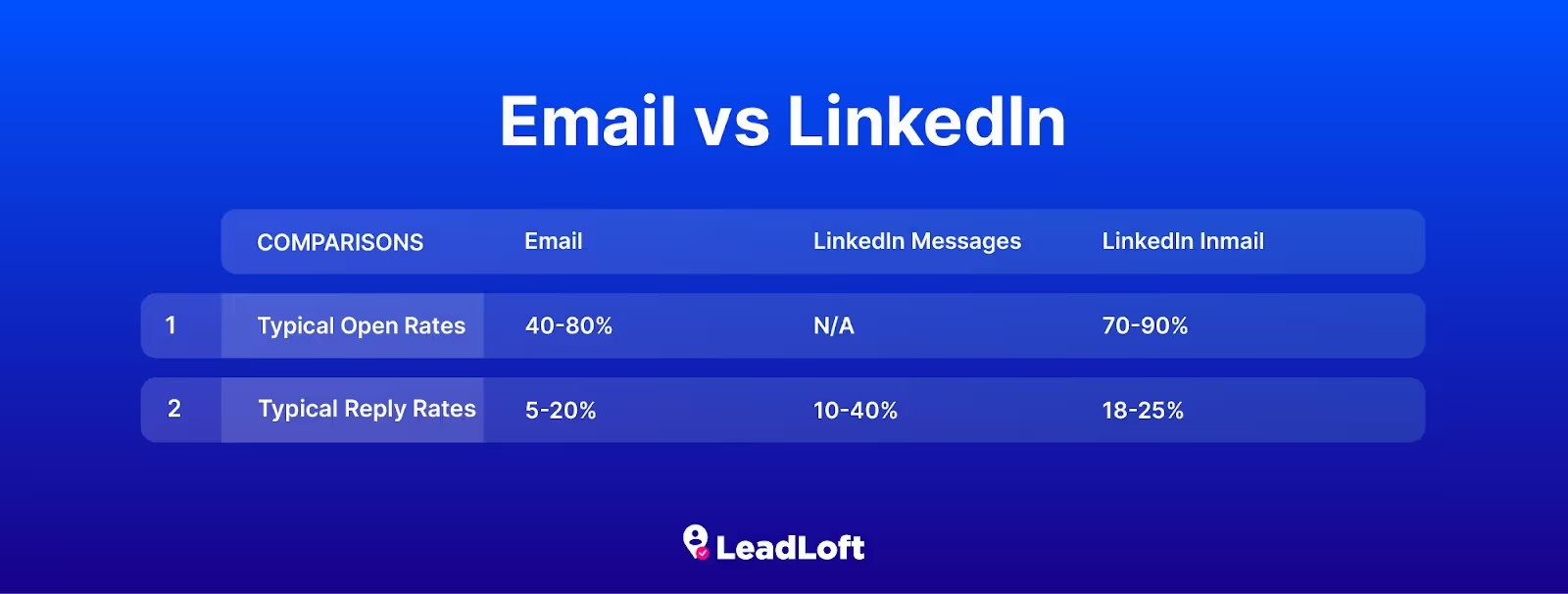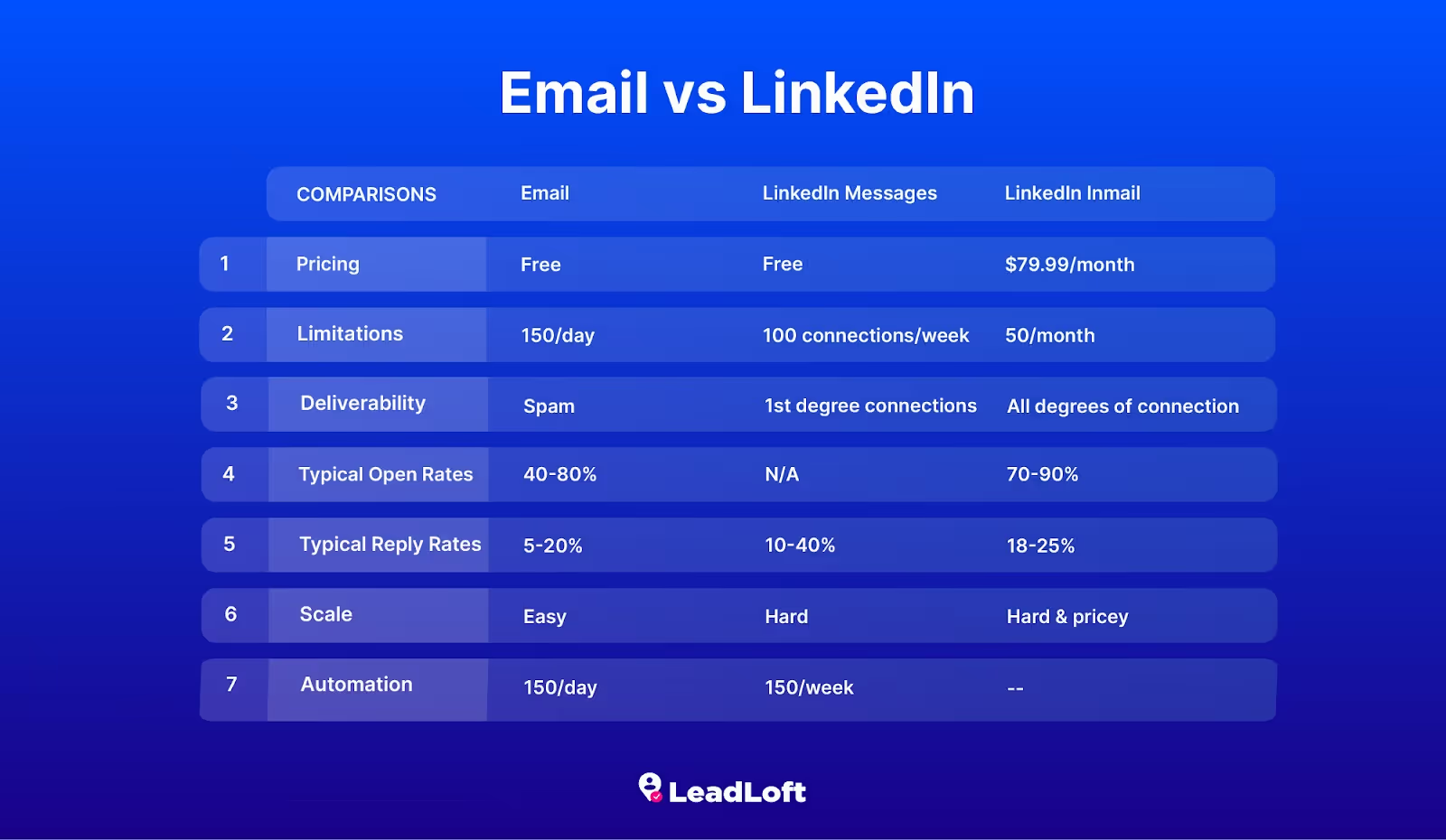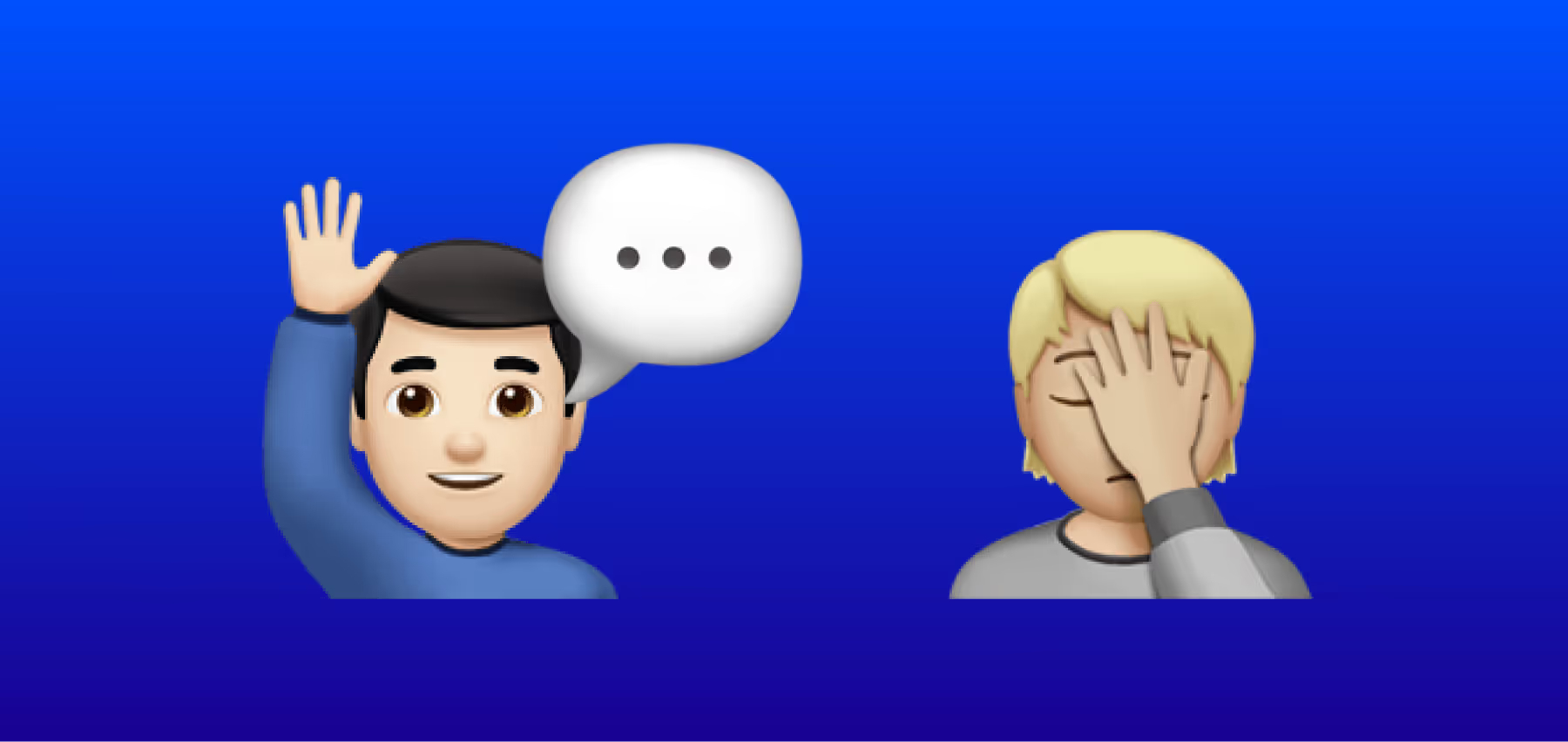Cold Email Vs LinkedIn Outreach: Which is Best?


With the rise of social media in recent years, LinkedIn has climbed to the top of the list in lead generation channels, with over 80% of B2B social media leads coming from LinkedIn alone. However, email remains one of the essential channels for outbound marketing. More than 70% of our revenue comes from cold email, and about 90% of marketers say they still rely on email as their primary channel for lead generation.
Does this mean you must choose between email or LinkedIn for better outreach results? Not necessarily. But we've received a fair number of requests from our customers asking which one they should focus on first, so we figured we’d break it down for you.
Is LinkedIn or Email better for cold outreach?
With cold email, you can reach out to anyone, given you have their email address. With tools like Hunter.io and the LeadLoft Prospector, finding anyone's email is easier than ever.
On the other hand, you can reach out to over 900 million members on LinkedIn, one of the largest business-focused platforms in the world, making it just as powerful as email, if not more so.
If your target audience is businesses, then LinkedIn might be better to use. If you want to expand your reach as much as possible, consider using cold email. Ultimately, it comes down to what's right for you. But how do you determine which channel is right for you? Well, we’ll be breaking down the main benefits and disadvantages of both email and LinkedIn to help you decide.
Factors to Compare
- Price
- Outreach Limitations
- Deliverability
- Open and reply rates
- Scale
- Automation
1. Price
Based on price alone, businesses looking to maximize their number of leads with minimal cost will benefit from email, which only costs as much as your domain and your email service provider are charging you. Usually, it is around $10 to $20 per month for one email address.
Similarly, using LinkedIn for outreach is free, but it comes with a catch. If you're not a premium user on LinkedIn, the odds of getting blocked are far higher. This means most users using LinkedIn for outreach will eventually have to subscribe to one of LinkedIn's Premium plans. If you’re planning on using LinkedIn InMail credits, plan on paying a premium because they don't come cheap.
Sales Navigator is the cheapest to buy InMails at $79.99 per month for 50 InMail credits. That’s about $1.60 for each InMail. This is the plan we recommend for the best deal.

2. Outreach Limitations
When it comes to both email and LinkedIn outreach, both have limitations in place. For email, it may seem like it has no limits when you consider the fact that you can send 2,000 emails per day on Gmail and 10,000 per day on Outlook. However, email limits come into play when you start to discuss deliverability. In most cases, you never want to send more than ~150 emails per day on Gmail or you’ll risk getting your email sent to the spam folder. This means with email, you can only send around 100 to 200 emails per day.
For LinkedIn, the limitations are different but surprisingly similar. The biggest difference is that on LinkedIn, you can only send a direct message to your first-degree connections, and you're limited to sending 100 new connection requests per week, many of which will not accept your request. If you're not connected with somebody, you will not be able to send a direct message to them. Just like email, LinkedIn has no limit on the number of messages you can send per day, but it does have secret limitations in place. On email, the hidden limitation is emails going to the spam folder, while on LinkedIn, this limitation comes in the form of restricting or blocking your LinkedIn profile.
It's also worth noting that LinkedIn offers a paid option for sending messages known as InMail messages. So, if you're a paying user, you'll get 50 InMail credits per month, with each InMail costing one credit.
If you’re concerned that 50 InMail credits per month are not enough, don’t worry too much. LinkedIn recently updated its InMail credits policy so you can earn more credits. Under the new policy, every response you receive from an email message will be free, meaning no credit will be taken from your account. To put things simply, if someone responds, you're not spending an email credit. Just keep in mind that you can only accumulate up to 150 credits max. This isn't necessarily the most effective way of running LinkedIn outreach, but we thought it was worth mentioning.
At the end of the day, both services have their pros and cons, and deciding which one is right for you will ultimately depend on your use case and experience.
3. Deliverability
Spam is one of the main disadvantages email faces. According to Email Tool Tester, 15.8% of all emails go missing or get filtered into spam. LinkedIn messages and InMails do not face this problem.
If you want to bypass email spam filters, you can check out our guide to staying out of spam here.
But LinkedIn messages also have their downside. Since you can only send LinkedIn messages to first-degree connections, your scope of deliverability is also limited.
In contrast, you can send LinkedIn InMails to anyone regardless of your degree of connection without having to worry that it will be filtered as “spam.”
.avif)
4. Open and reply rates
When it comes to comparing open and reply rates for email and LinkedIn, it's really difficult to do so. It's even harder when you realize that all of the "experts" online can't agree on what the actual open and reply rates should be for each channel. These stats are all over the place.
One study conducted by Backlinko analyzed 12 million cold emails. It found that, on average, only about 8.5% of cold emails receive responses. Similarly, open rates fluctuate anywhere from 1-10% on average. Again, these are just benchmarks, and in our experience, both a reply rate of 10-20% and an open rate of 80%+ are achievable with a well-written cold email.
This study isolated multiple variables, from personalization to the length of the ideal subject line. Here are the main takeaways:
Personalized emails have an increased 32.7% response rate compared to emails that are not personalized.
Outreach emails with long subject lines have a 24.6% higher average response rate than those with short subject lines. The ideal length of a subject line is about 36-50 characters.
Personalizing subject lines can boost response rates by up to 30.5%, which has a significant impact on the effectiveness of outreach campaigns.
Now, let's compare cold emails to LinkedIn's open and reply rates.
LinkedIn is known for its high engagement levels with messages, with LinkedIn messages having reply rates of 10-40% and InMail having reply rates up to 18-25%. InMail response rates are approximately three times higher than email, and its open rates can reach as high as 70-90%.
Here's a quick recap of cold email and LinkedIn's rates:

If you’re curious about your open and reply rates, you can use LeadLoft to track your progress.
5. Scale
With email, you can technically send up to 2,000 emails a day for one account, but this only increases the chances of your emails landing in spam. To prevent this, you should send 100 to 200 emails per day. That means you can send up to 1400 emails per week, while with LinkedIn, you can connect with 100 people at most per week. From these stats alone, email has the bigger advantage.
A quick way to scale prospecting is to create multiple accounts. This will be more difficult with LinkedIn since having more than one account under your name is against their Terms of Service. Furthermore, if you want to send more InMails with this method, you’ll have to pay more to afford a second Sales Navigator account. You can check out this blog for tips on how to effectively scale cold emails.
6. Automation
With a push of a button, you can send messages to hundreds of people via email and LinkedIn. Just keep in mind the limit for LinkedIn is roughly 150 per week before you risk getting banned; for email, it’s 150 per day before your emails have a chance of being sent to the spam folder. In this sense, automation for email and LinkedIn proves to be time-saving.
However, automated messages can sound cold and detached, decreasing the chances of prospects reading your messages. So if you plan to send messages in bulk, it’s crucial that you use segmentation and personalize your emails and/or LinkedIn messages.
So Which Should You Use?
Here’s a table summarizing all the advantages and disadvantages of using cold email, LinkedIn messages, and InMails:

At first glance, it probably looks like LinkedIn has far better stats than email, and this is true on the surface. But once you begin to dive into everything, you'll realize that LinkedIn relies heavily on your prospects' willingness to accept your connection request and on whether they use LinkedIn at all. At the end of the day, if you never connect with your prospect, your options for outreach will be extremely limited. Email doesn't have this issue, which gives you the ability to contact anyone regardless of whether or not they use LinkedIn. This is the reason why it's so powerful.
So when it comes down to it, both platforms are pretty amazing for running outreach, and both have their limitations. If you're not super tech-savvy, it's probably best to start with LinkedIn because connecting and sending a message is about as straightforward as outreach can get. If you're a bit more tech-savvy, email might be a better option because it will allow you to contact more people in more industries.
Regardless, once you've mastered one channel, you should incorporate the other. This is known as multi-channel outreach, and it's a great way to take your outreach to the next level. Even if you're struggling with one channel, adding another can double your results so incorporating both is a surefire way to maximize your results.
If this is something you're interested in setting up, check out LeadLoft to set up email and Linkedin outreach. We’re more than happy to set your team up so you can hit the ground running with an outreach workflow we’ve tested and know works.




.avif)

